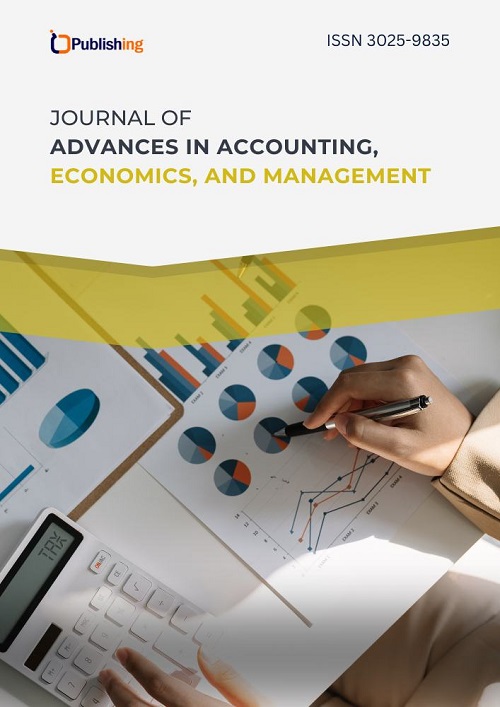Team Problem-Solving with Agile Business Process to Improve Employee Performance Using NVIVO Analysis at PT XYZ
DOI:
https://doi.org/10.47134/aaem.v2i1.444Keywords:
Agile Ways of Working, Employee Performance, Project Management, ScrumAbstract
To achieve optimal performance, telecommunications companies, particularly PT XYZ, which are closely aligned with technological advancements, must develop strategic frameworks to address evolving market demands and sustain their operational viability. PT XYZ faces several collaboration-related challenges, including iterative redundancies, insufficient project transparency, inadequate cross-functional communication, and ineffective inter-departmental coordination. To address these issues and enhance organizational performance, PT XYZ has adopted Agile Ways of Working. This qualitative study aims to examine employee behavior at PT XYZ in relation to their experiences with the transition to Agile Ways of Working. The research involved interviewing six informants with relevant roles and experience in the Agile transformation, conducted online and recorded for data collection. The interview data were subsequently analyzed using NVIVO 12 Pro software. The findings suggest that for effective implementation of Agile Ways of Working, organizations must first identify and understand the challenges they will encounter in order to devise appropriate solutions. It is crucial to invest in employee competency development through targeted training and workshops and to support these initiatives with company policies that align with agile principles. PT XYZ utilize the Scrum Framework due to its rapid adaptability to change. The implementation of Agile Ways of Working at PT XYZ has been assessed as effective, enhancing collaboration, streamlining communication between individuals and departments, and proving suitable for application within the telecommunications sector.
References
Aditya, F. (2023). PENGEMBANGAN SISTEM INFORMASI EKSPEDISI PT ESL MENGGUNAKAN METODE AGILE.
Agus B. Siswanto, & M. Afif Salim. (2019). Manajemen Proyek.
Bakti, G. S. S., & Rubiyanti, R. N. (2021). PENGARUH KUALITAS PELAYANAN TERHADAP KEPUASAN KONSUMEN DI PT. SURYA ENERGI INDOTAMA THE EFFECT OF SERVICE QUALITY ON CUSTOMER SATISFACTION AT PT. SURYA ENERGI INDOTAMA.
Berntzen, M., Stray, V., & Moe, N. B. (2021). Coordination Strategies: Managing Inter-team Coordination Challenges in Large-Scale Agile. Lecture Notes in Business Information Processing, 419 LNBIP, 140–156. https://doi.org/10.1007/978-3-030-78098-2_9
Conboy, K., & Carroll, N. (2019). Implementing Large-Scale Agile Frameworks: Challenges and Recommendations. In IEEE Software (Vol. 36, Issue 2, pp. 44–50). IEEE Computer Society. https://doi.org/10.1109/MS.2018.2884865
Dumas, M., La Rosa, M., Mendling, J., & Reijers, H. A. (2019). Fundamentals of Business Process Management. In Fundamentals of Business Process Management. Springer Berlin Heidelberg. https://doi.org/10.1007/978-3-642-33143-5
Eddy Roflin, & Ferani Eva Zulvia. (2021). Kupas Tuntas Analisis Korelasi (M. Nasrudin, Ed.). PT Nasya Expanding Management.
Eskola, A. (2018). Navigating Through Changing Times: Knowledge Work in Complex Environment. Routledge.
Firmansyah, M., & Christian. (2022). Pengembangan dan Implementasi Desain UI/UX Website Sistem Laporan Keuangan di SMK Multistudi High School Batam Menggunakan Kerangka Kerja Agile Scrum.
Grass, A., Backmann, J., & Hoegl, M. (2020). From Empowerment Dynamics to Team Adaptability: Exploring and Conceptualizing the Continuous Agile Team Innovation Process. Journal of Product Innovation Management, 37(4), 324–351. https://doi.org/10.1111/jpim.12525
Hafni Sahir, S. (2022). Metodologi Penelitian. www.penerbitbukumurah.com
Hartini, Fadlillah, A. M., Ismainar, H., Setyorini Ahmad Bairizki, R., Muftiasa, A., Manuhutu, M.,
Ramadhani, I., Yuningsih Titus Kristanto, E., Hidayatunnisa, N., & Aziz, F. (2021). Kinerja Karyawan Konsep Penilaian Kinerja di Perusahaan. www.penerbitwidina.com
Hertantyo, N. (2020). MANAJEMEN PROYEK AGILE DENGAN SCRUM : STUDY KASUS PROYEK PEMBANGUNAN SISTEM DINAS KOMUNIKASI DAN INFORMATIKA JAWA TIMUR.
Hidayaturrahman, M. (2021). Metodologi penelitian sosial perspektif kualitatif kuantitatif. https://www.researchgate.net/publication/353572200
Kaharuddin. (2021). Kualitatif : Ciri dan Karakter Sebagai Metodologi. Jurnal Pendidikan, 1, 2–3. http://journal.unismuh.ac.id/index.php/equilibrium
Kamaluddin, L. A., Firman, A., & Agussalim. (2023). Komunikasi dan Kerjasama Tim Terhadap Peningkatan Kinerja Pegawai. In YUME : Journal of Management (Vol. 6, Issue 3).
Kasauli, R., Knauss, E., Horkoff, J., Liebel, G., & de Oliveira Neto, F. G. (2021). Requirements engineering challenges and practices in large-scale agile system development. Journal of Systems and Software, 172. https://doi.org/10.1016/j.jss.2020.110851
Kent Beck, Mike Beedle, Arie van Bennekum, Alistair Cockburn, Ward Cunningham, Martin Fowler, James Grenning, Jim Highsmith, Narasumber 3w Hunt, Ron Jeffries, Jon Kern, Brian Marick, Robert C. Martin,
Steve Mellor, Ken Schwaber, Jeff Sutherland, & Dave Thomas. (2001). Manifesto for Agile Software Development. https://agilemanifesto.org/
Mike Cohn. (2005). Agile Estimating and Planning (Robert C. Martin). Pearson Education Inc.
Muhajir Dalimunthe, M., & Madiistriyatno, H. (2023). PENGARUH AGILE METHODOLOGY DALAM STRATEGI DIGITALISASI DI PT. SATORU PRIMA INTERNASIONAL. Lentera: Studi Multidisiplin, 2(1). https://lentera.publikasiku.id/index.php
Muhammad Ikhwan Burhan, Fadliyani Nawir, & Karta Negara Salam. (2022). Pengembangan Sistem Tracer Study Menggunakan Agile Development Methods pada IBK Nitro. JURSIMA (Jurnal Sistem Informasi Dan Manajemen).
Nur Wachidah, L., & Saleh Luturlean, B. (2019). PENGARUH DISIPLIN KERJA TERHADAP KINERJA KARYAWAN PERUM BULOG DIVISI REGIONAL JAWA BARAT. https://doi.org/10.31955/mea.vol3.iss2.pp51-57
PRASTIO, A. (2023). PENGEMBANGAN APLIKASI FARM MANAGEMENT DENGAN FRAMEWORK SCRUM & KANBAN DI PT BEJANA INVESTIDATA GLOBALINDO (BIGIO).
Pujiyono, B. (2009a). Konsep Manajemen Proyek.
Pujiyono, B. (2009b). Konsep Manajemen Proyek.
Reginaldo, F., & Santos, G. (2020). Challenges in Agile Transformation Journey: A Qualitative Study. ACM International Conference Proceeding Series, 11–20. https://doi.org/10.1145/3422392.3422436
Russo, D. (2021). The Agile Success Model: A Mixed Methods Study of a Large-Scale Agile Transformation. ACM Trans. Softw. Eng. Methodol, 37(111), 45. https://doi.org/10.1145/1122445
Sujono, S., Setiawan, M. A., & Haryono, K. (2020). Tantangan Adopsi Agile di Perguruan Tinggi di Indonesia (Challenges of Agile Adoption in Higher Education in Indonesia) (Vol. 8, Issue 2).
SULASTRININGSIH, S. (2022). IMPLEMENTASI METODE AGILE DEVELOPMENT UNTUK SISTEM INFORMASI EVENT MANAGEMENT PADA PT. PENTAS MENARA KOMINDO.
Surapto, D., Dwita, F., & Rahman, A. (2022). Pengaruh Agile Leadership, Beban Kerja, dan Kepuasan Kerja terhadap Kinerja Karyawan. 4(1).
Suryantara, I. G. N. (2021). Pengembangan Aplikasi Penjualan Mobil dengan Framework Scrum pada PT XYZ. Go-Integratif : Jurnal Teknik Sistem Dan Industri, 2(2), 70–85. https://doi.org/10.35261/gijtsi.v2i2.5326
Weske, M. (2007). Business Process Management.
Zein Adin. (2023). Dasar-Dasar Komunikasi Bisnis. Jurnal Riset Manajemen Komunikasi, 3(1). https://doi.org/10.29313/jrmk.v3i1.2324
Downloads
Published
How to Cite
Issue
Section
License
Copyright (c) 2024 Arif Kuswanto, Abida Qonita

This work is licensed under a Creative Commons Attribution 4.0 International License.








